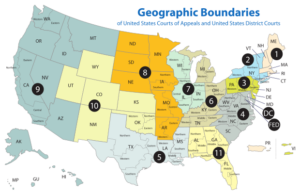The United States federal court system is a hierarchical structure consisting of three levels: the district courts, the courts of appeals, and the Supreme Court. District courts are trial-level courts who have jurisdiction over a wide range of federal cases, including criminal cases, civil cases involving federal law, and cases involving federal agencies. The courts of appeals are intermediate appellate courts, who hear appeals from the district courts and other federal agencies within their geographic jurisdiction. The Supreme Court is the highest court in the United States, and has the final say on all cases involving federal law and the United States Constitution.
 The federal court system was established by the Constitution, which gives Congress the power to create and regulate federal courts. Our first federal courts were created by the Judiciary Act of 1789, which only established district courts and the Supreme Court. The Act also created the Office of the Attorney General and provided for the appointment of federal judges by the President, with the advice and consent of the Senate.
The federal court system was established by the Constitution, which gives Congress the power to create and regulate federal courts. Our first federal courts were created by the Judiciary Act of 1789, which only established district courts and the Supreme Court. The Act also created the Office of the Attorney General and provided for the appointment of federal judges by the President, with the advice and consent of the Senate.
Over time, the federal court system has evolved and expanded to meet our country’s changing needs. The number of federal district courts and judges has increased while new courts of appeals have been established.
The Ninth Circuit Court of Appeals has jurisdiction over cases from the western United States. It was established in 1891 and its initial jurisdiction was later expanded to include the territories of Alaska, Arizona, Guam, and Hawaii.
The Ninth Circuit is one of 13 circuits in the federal court system, and it is known for its large size and diverse jurisdiction. It hears appeals from the district courts in its jurisdiction, as well as from certain federal agencies and administrative bodies. The court is headquartered in San Francisco and has additional locations in Pasadena, Phoenix, and Seattle.
The Ninth Circuit has a reputation for being one of the more liberal circuits in the federal court system, and it has issued a number of significant decisions on a wide range of issues, including civil rights, environmental law, and criminal law. Some of its notable cases include Miranda v. Arizona, which established the right to remain silent and have an attorney present during police interrogations, and United States v. Microsoft, which dealt with antitrust issues related to the company’s dominance in the software industry.
The Ninth Circuit has also recently issued momentous decisions:
- In 2017, the Ninth Circuit ruled that the Trump administration’s travel ban, which restricted travel from several Muslim-majority countries, was unconstitutional. The court found in Hawaii, et al. v. Trump, et al. that the ban violated the Establishment Clause of the First Amendment, which prohibits the government from favoring one religion over another.
- In 2020, the Ninth Circuit ruled that the Second Amendment does not protect the right to openly carry a firearm in public. The case, Young v. Hawaii, involved a challenge to Hawaii’s law prohibiting the open carrying of firearms in public, and the court found that the law did not violate the Second Amendment.
- In 2021, the Ninth Circuit ruled that the Deferred Action for Childhood Arrivals (DACA) program, which provides protection from deportation to certain individuals who were brought to the United States as children, was legal. Regents of the Univ. of CA, et al. v. U.S. Dep’t of Homeland Sec. was a victory for DACA supporters, which had been challenged by the Trump administration.
The court continues to play a key role in shaping the law in the western United States and beyond.